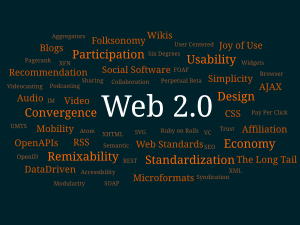
Back ويب 2.0 Arabic Veb 2.0 Azerbaijani Web 2.0 BAR Web 2.0 Bulgarian ওয়েব ২.০ Bengali/Bangla Web 2.0 Catalan Web 2.0 Czech Web 2.0 Danish Web 2.0 German Web 2.0 Greek

Web 2.0 (also known as participative (or participatory)[1] web and social web)[2] refers to websites that emphasize user-generated content, ease of use, participatory culture, and interoperability (i.e., compatibility with other products, systems, and devices) for end users.
The term was coined by Darcy DiNucci in 1999[3] and later popularized by Tim O'Reilly and Dale Dougherty at the first Web 2.0 Conference in 2004.[4][5][6] Although the term mimics the numbering of software versions, it does not denote a formal change in the nature of the World Wide Web,[7] but merely describes a general change that occurred during this period as interactive websites proliferated and came to overshadow the older, more static websites of the original Web.[2]
A Web 2.0 website allows users to interact and collaborate through social media dialogue as creators of user-generated content in a virtual community. This contrasts the first generation of Web 1.0-era websites where people were limited passively viewing content. Examples of Web 2.0 features include social networking sites or social media sites (e.g., Facebook), blogs, wikis, folksonomies ("tagging" keywords on websites and links), video sharing sites (e.g., YouTube), image sharing sites (e.g., Flickr), hosted services, Web applications ("apps"), collaborative consumption platforms, and mashup applications.
Whether Web 2.0 is substantially different from prior Web technologies has been challenged by World Wide Web inventor Tim Berners-Lee, who describes the term as jargon.[8] His original vision of the Web was "a collaborative medium, a place where we [could] all meet and read and write".[9][10] On the other hand, the term Semantic Web (sometimes referred to as Web 3.0)[11] was coined by Berners-Lee to refer to a web of content where the meaning can be processed by machines.[12]
- ^ Blank, Grant; Reisdorf, Bianca (2012-05-01). "The Participatory Web". Information. 15 (4): 537–554. doi:10.1080/1369118X.2012.665935. ISSN 1369-118X. S2CID 143357345.
- ^ a b "What is Web 1.0? - Definition from Techopedia". Techopedia.com. Archived from the original on 2018-07-13. Retrieved 2018-07-13.
- ^ DiNucci, Darcy (1999). "Fragmented Future" (PDF). Print. 53 (4): 32. Archived (PDF) from the original on 2011-11-10. Retrieved 2011-11-04.
- ^ Graham, Paul (November 2005). "Web 2.0". Archived from the original on 2012-10-10. Retrieved 2006-08-02.
I first heard the phrase 'Web 2.0' in the name of the Web 2.0 conference in 2004.
- ^ O'Reilly, Tim (2005-09-30). "What Is Web 2.0". O'Reilly Network. Archived from the original on 2013-04-24. Retrieved 2006-08-06.
- ^ Strickland, Jonathan (2007-12-28). "How Web 2.0 Works". computer.howstuffworks.com. Archived from the original on 2015-02-17. Retrieved 2015-02-28.
- ^ Sykora, M. (2017). "Web 1.0 to Web 2.0: an observational study and empirical evidence for the historical r(evolution) of the social web". International Journal of Web Engineering and Technology. 12: 70. doi:10.1504/IJWET.2017.084024. S2CID 207429020.
- ^ Cite error: The named reference
developerWorks Interviews: Tim Berners-Leewas invoked but never defined (see the help page). - ^ "Berners-Lee on the read/write web". BBC News. 2005-08-09. Archived from the original on 2012-09-01. Retrieved 2012-08-05.
- ^ Richardson, Will (2009). Blogs, Wikis, Podcasts, and Other Powerful Web Tools for Classrooms (2nd ed.). California: Corwin Press. p. 1. ISBN 978-1-4129-5972-8.
- ^ "What is Web 3.0? Webopedia Definition". www.webopedia.com. Archived from the original on 2017-02-15. Retrieved 2017-02-15.
- ^ Berners-Lee, Tim; James Hendler; Ora Lassila (May 17, 2001). "The Semantic Web" (PDF). Scientific American. 410 (6832): 1023–4. Bibcode:2001SciAm.284e..34B. doi:10.1038/scientificamerican0501-34. PMID 11323639. Archived (PDF) from the original on October 1, 2018. Retrieved October 1, 2018.